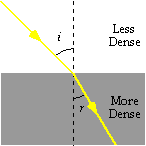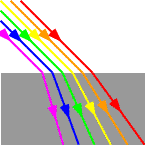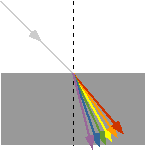10.1 Reflection and Refraction
(Discovering the Universe, 5th ed., §4.x)
- We have already seen that, while light usually travels in a straight
line, a massive object can deflect it.
It is also possible to change its motion by means of material devices such
as shiny surfaces, transparent materials, and apertures.
 A basic property of light is reflection, a redirection of its
motion by a shiny surface such as a mirror. A basic property of light is reflection, a redirection of its
motion by a shiny surface such as a mirror.
Measuring from the perpendicular to the surface, the angle of incidence
i is always equal to the angle of reflection r.
Reflection can be explained by conservation of momentum along the surface but a reversal of momentum perpendicular to the surface.
Question: what would be required to cause a reversal of momentum?
 Light will also change directions when passing from one transparent medium into another, a property known as refraction. Light will also change directions when passing from one transparent medium into another, a property known as refraction.
The angle of refraction r will depend not only on the angle of incidence i but also on the two materials through which the light passes.
Whichever way the light is traveling, the angles will be larger in the less dense medium, such as vacuum or air, and smaller in the more dense medium, such as water or glass.
Refraction can be explained by assuming that, in denser media, light travels more slowly (less than the speed in vacuum, c), which has been verified by experiment.
Most materials that refract light will also partially reflect it.
Question: can you think of an example of this?
 The angle of refraction will also depend on the color of the light. The angle of refraction will also depend on the color of the light.
For the same angle of incidence, red light will be refracted the least, with orange, yellow, green, and blue each being refracted increasingly more, and with violet being refracted the most.
The mnemonic ROYGBV ("roy g. biv") can be used to remember the color order.
This variation in angle of refraction implies that different colors travel at slightly different speeds in dense media, red being the fastest and violet the slowest.
 When white light is refracted, one finds that it spreads out into a rainbow of colors, or spectrum, in the order given above. When white light is refracted, one finds that it spreads out into a rainbow of colors, or spectrum, in the order given above.
The spreading out of light into a spectrum is called dispersion.
- In addition to his work on motion and gravity, Isaac Newton also studied light and its dispersion.
Newton demonstrated that a spectrum dispersed from white light could be recombined back into white light.
Newton therefore concluded that white light is a mixture of all colors, instead of the alternative theory that the colors were properties of the materials with which light interacts.
|